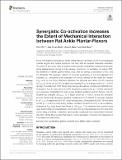| dc.contributor.author | Tijs, Chris | en_US |
| dc.contributor.author | van Dieën, Jaap H. | en_US |
| dc.contributor.author | Baan, Guus C. | en_US |
| dc.contributor.author | Maas, Huub | en_US |
| dc.date.accessioned | 2016-11-18T20:48:07Z | |
| dc.date.issued | 2016 | en_US |
| dc.identifier.citation | Tijs, Chris, Jaap H. van Dieën, Guus C. Baan, and Huub Maas. 2016. “Synergistic Co-activation Increases the Extent of Mechanical Interaction between Rat Ankle Plantar-Flexors.” Frontiers in Physiology 7 (1): 414. doi:10.3389/fphys.2016.00414. http://dx.doi.org/10.3389/fphys.2016.00414. | en |
| dc.identifier.issn | 1664-042X | en |
| dc.identifier.uri | http://nrs.harvard.edu/urn-3:HUL.InstRepos:29408379 | |
| dc.description.abstract | Force transmission between rat ankle plantar-flexors has been found for physiological muscle lengths and relative positions, but only with all muscles maximally activated. The aims of this study were to assess intermuscular mechanical interactions between ankle plantar-flexors during (i) fully passive conditions, (ii) excitation of soleus (SO), (iii) excitation of lateral gastrocnemius (LG), and (iv) during co-activation of SO, and LG (SO&LG). We assessed effects of proximal lengthening of LG and plantaris (PL) muscles (i.e., simulating knee extension) on forces exerted at the distal SO tendon (FSO) and on the force difference between the proximal and distal LG+PL tendons (ΔFLG+PL) of the rat. LG+PL lengthening increased FSO to a larger extent (p = 0.017) during LG excitation (0.0026 N/mm) than during fully passive conditions (0.0009 N/mm). Changes in FSO in response to LG+PL lengthening were lower (p = 0.002) during SO only excitation (0.0056 N/mm) than during SO&LG excitation (0.0101 N/mm). LG+PL lengthening changed ΔFLG+PL to a larger extent (p = 0.007) during SO excitation (0.0211 N/mm) than during fully passive conditions (0.0157 N/mm). In contrast, changes in ΔFLG+PL in response to LG+PL lengthening during LG excitation (0.0331 N/mm) were similar (p = 0.161) to that during SO&LG excitation (0.0370 N/mm). In all conditions, changes of FSO were lower than those of ΔFLG+PL. This indicates that muscle forces were transmitted not only between LG+PL and SO, but also between LG+PL and other surrounding structures. In addition, epimuscular myofascial force transmission between rat ankle plantar-flexors was enhanced by muscle activation. However, the magnitude of this interaction was limited. | en |
| dc.language.iso | en_US | en |
| dc.publisher | Frontiers Media S.A. | en |
| dc.relation.isversionof | doi:10.3389/fphys.2016.00414 | en |
| dc.relation.hasversion | http://www.ncbi.nlm.nih.gov/pmc/articles/PMC5030264/pdf/ | en |
| dash.license | LAA | en_US |
| dc.subject | soleus | en |
| dc.subject | gastrocnemius | en |
| dc.subject | plantaris | en |
| dc.subject | connective tissue | en |
| dc.subject | Achilles tendon | en |
| dc.subject | co-activation | en |
| dc.title | Synergistic Co-activation Increases the Extent of Mechanical Interaction between Rat Ankle Plantar-Flexors | en |
| dc.type | Journal Article | en_US |
| dc.description.version | Version of Record | en |
| dc.relation.journal | Frontiers in Physiology | en |
| dash.depositing.author | Tijs, Chris | en_US |
| dc.date.available | 2016-11-18T20:48:07Z | |
| dc.identifier.doi | 10.3389/fphys.2016.00414 | * |
| dash.contributor.affiliated | Tijs, Chris | |


